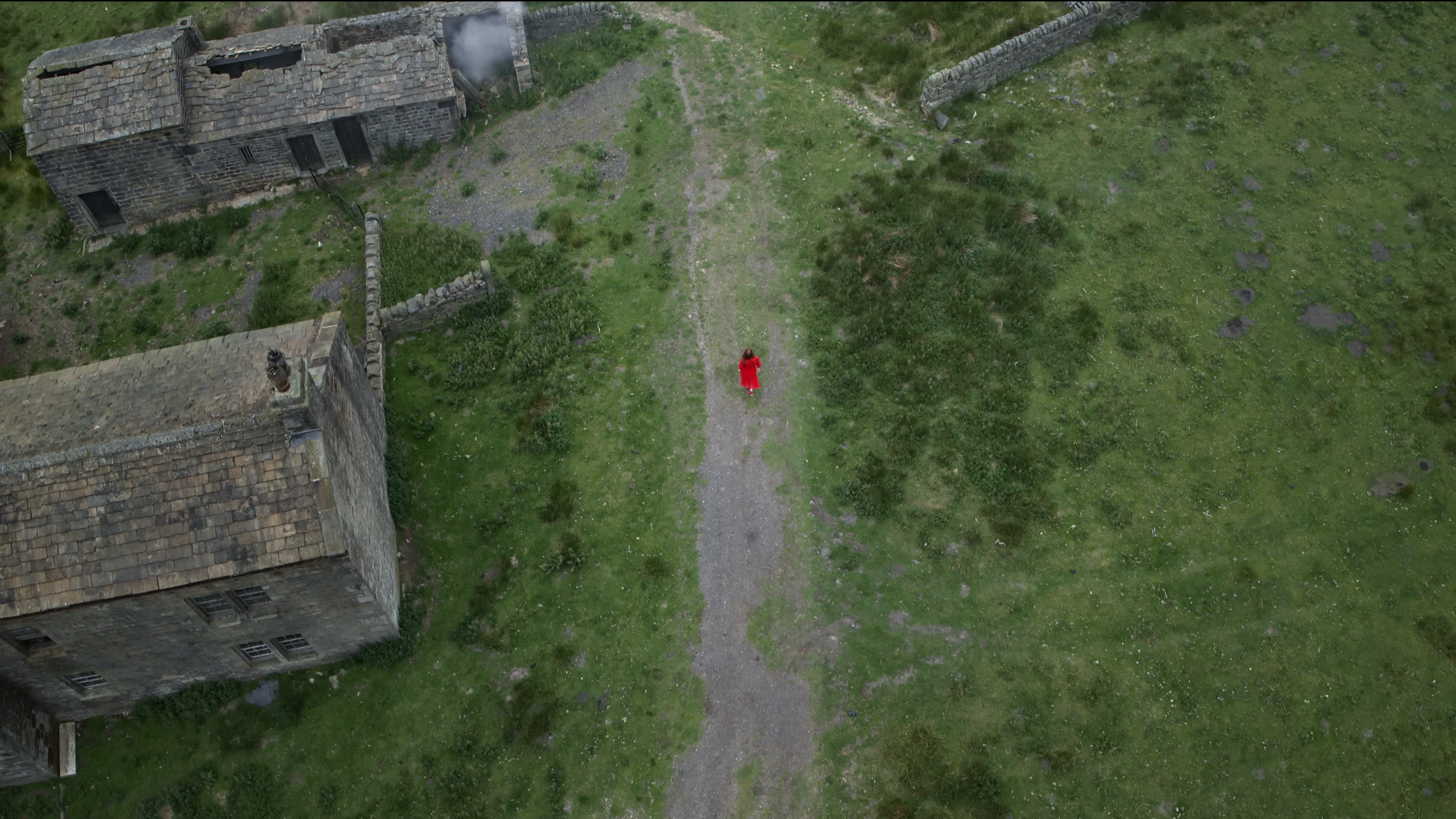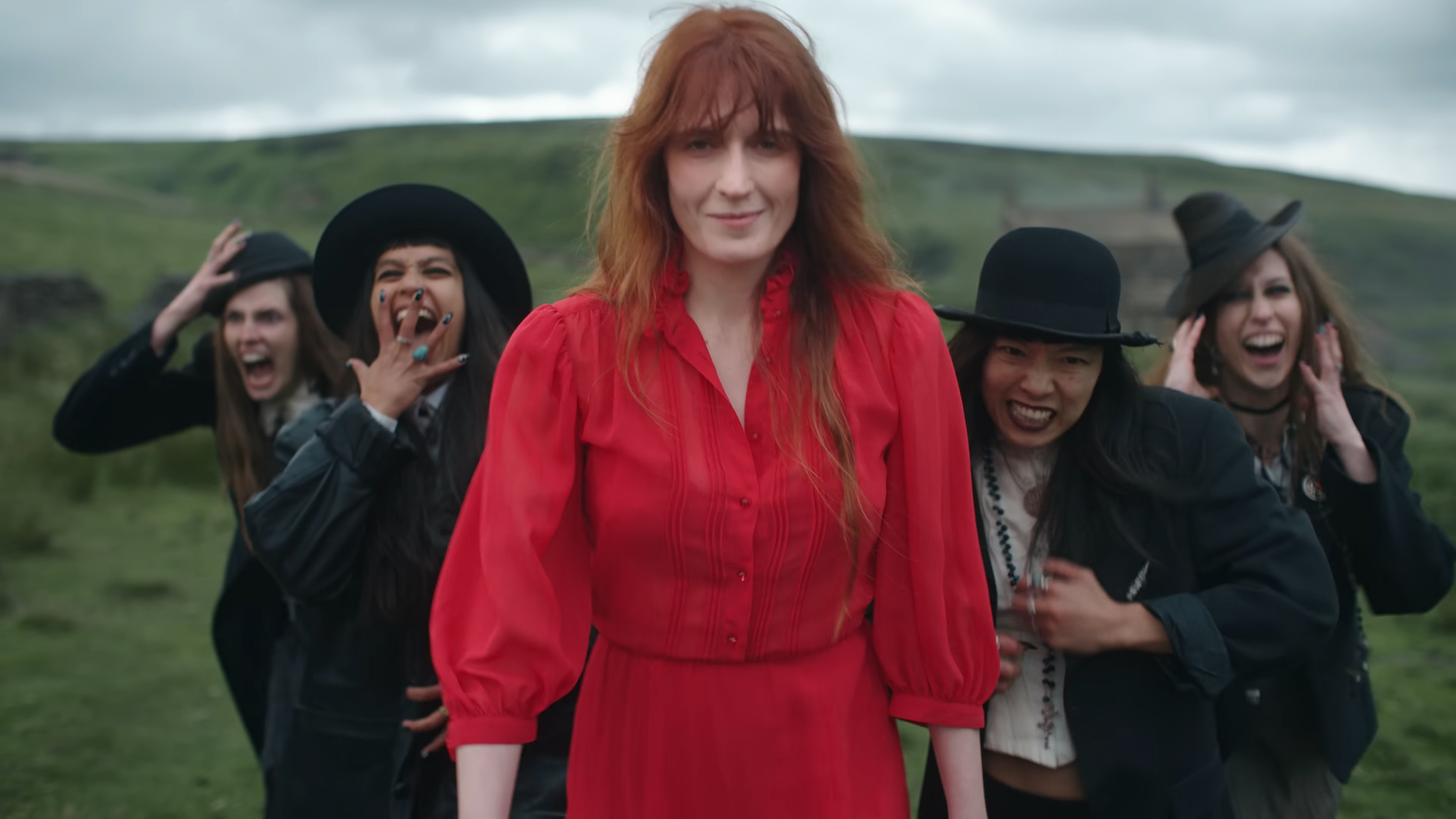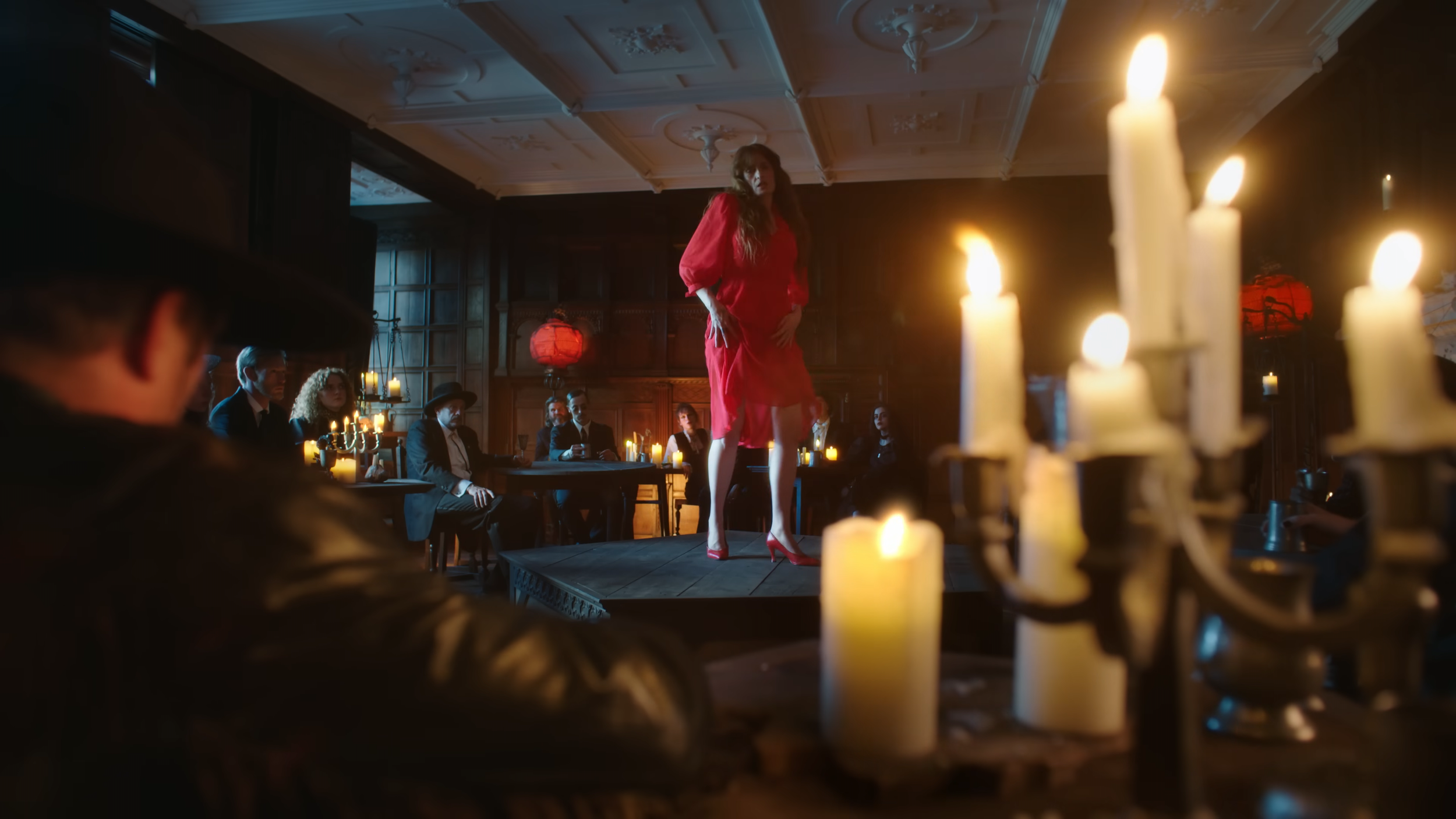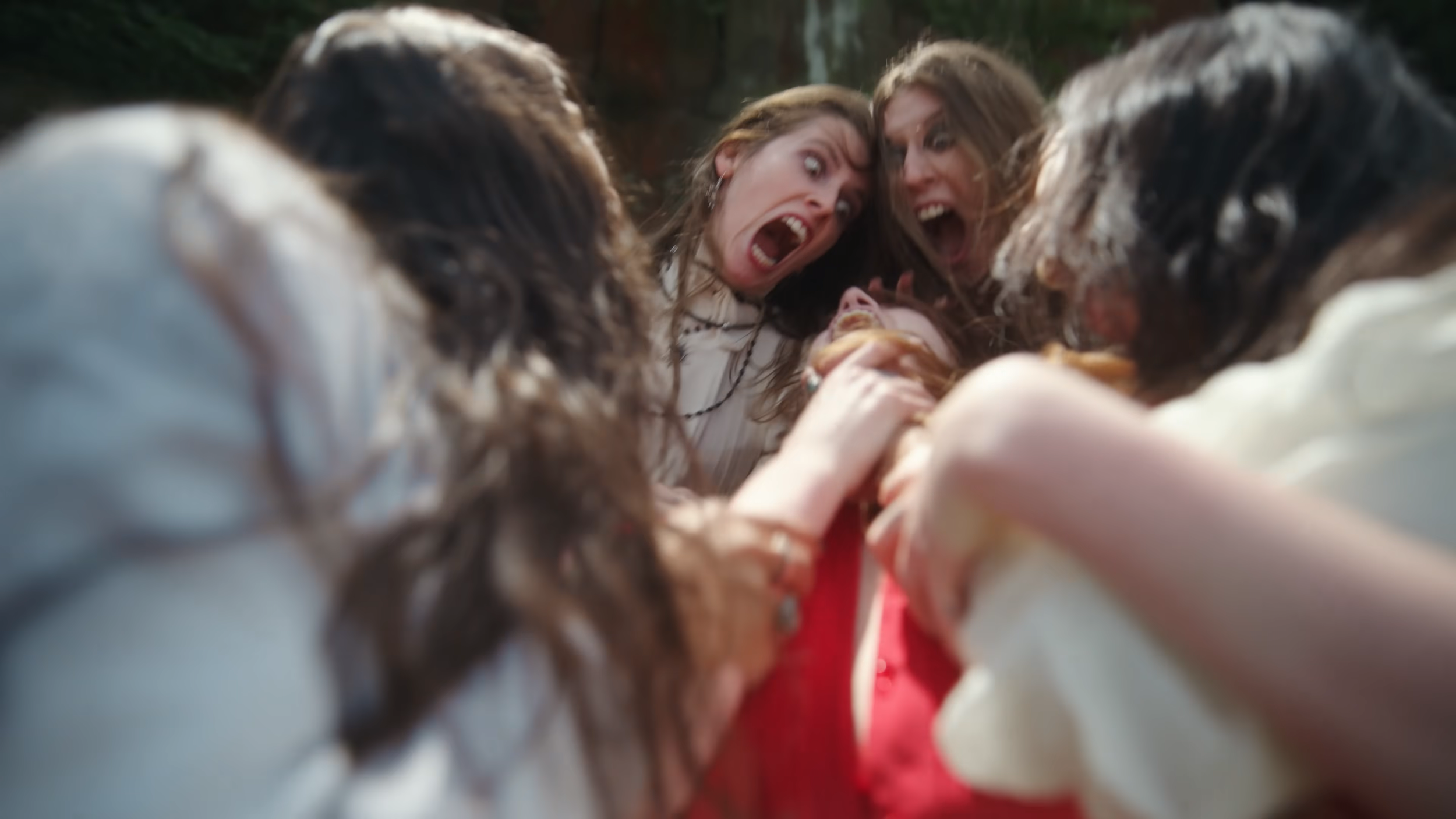Everybody Scream - music video analysis
Everybody Scream - what a video! In our almost ritualistic fashion, here’s our interpretation of the video for your perusal, as we try to unpick some of the creative processes and analyse deeper beyond what are simply stunning visuals and colours. Feel free to comment your own thoughts too!
The video begins with Florence wandering a barren land alone. It’s vast, scary, daunting and very raw. This symbolises her day-to-day life outside of her career. There’s a well-trodden path. Perhaps this symbolises the ‘path of life’; one walked many times, although somehow it still feels aimless. In her bold red dress, Florence stands out against the green landscape. In the tension between the pull of being a performer and the pull of wanting to live a quiet life out of the public eye, Florence feels alone, strange, and a lack of belonging in the world.
The shot cuts to Florence standing in a room, opulent and structured. She’s waving her arms; conducting. She’s at home here. It appears she is practising - preparing for a show. In contrast, the red dress is something that adds to the performance in this context, rather than something that makes her stand out. It highlights the duality of her image in day-to-day life, and as a performer on stage.
Florence is back to navigating the vast landscape alone. A man rides a horse in the distance along the same track Florence is following. Perhaps this is a symbolism for a multitude of things: a patriarchy, carving out a life for a woman who feels she does not conform yet is obliged to follow; a representation of always feeling behind when others charge ahead (she is on foot, after all). The man sits straddling the horse in the wrong direction, adding to the feeling of unease and wrongness of the dynamic. Perhaps the person carving out Florence’s life is doing so under the illusion that they know what is best for her future, but in fact hypocritically, they cannot even face it themselves.
Suddenly, Florence unleashes her support: a coven of witches - her songs, artistry, performance - that continues to guide her and give her newfound power beyond what she is able to reach in the day-to-day. They cast spells of illusion and influence. Her expression turns from one of unease to confidence, and her stride becomes such too: she is taking back power, using her artistry. It’s unhinged, feral, untamed, but that’s exactly what lends her the upper hand. The authority strikes a match and immediately extinguishes it. Again, this can be interpreted in many ways. Fire and ignition can signify the start of a spell. The fact it is blown out immediately could highlight the ways people in her life attempt to blow out the flame in her artistry, thus removing her power. It could also signify loss of something she almost had - a relationship, a project, or anything else she desires but feels out of reach.
The next shot shows burning candles. Florence has taken control in a room (the stage) where she feels most powerful. Here, she has the authority. The candles are lit and the fire-fuelled spell she is casting over her audience is very much in full flow. They are possessed by her energy as she and her songs command the audience to move, scream, shake. Note their positions - Florence and her coven are all mounted on some sort of stage, and everyone else is subordinate to this. Her power is visceral - running her hands from legs to her head to embody the way her energy flows in performance towards her mouth (singing) and out into the venue.
The man who was riding the horse is also here, and he does not look impressed. He is yet to be taken by the spell; the patriarch resisting the pull of her influence, always present and attempting to bring Florence back down to earth in a place where performance allows her to fly. She physically commands him, pushing him down and mounting him, exerting her femininity to remove his power. In her mouth, she holds purple pansies; associated with reflection, thought, and admiration. She showers these on him from her mouth. Metaphorically speaking, she is singing songs that spill from her mouth to command admiration from those who might otherwise not do so.
The scene cuts outdoors again into the vast landscape - a symbolism of the real world away from her career. A new stage is set here. The tone shifts - Florence is no longer in power. She is isolated. She attempts to use what she has learnt on stage but it does not work. Instead, her creativity and art act as a restraint, suffocating her. What had previously been at her side in aid - her art - in fact has damaged (see Florence cutting her foot on stage, breaking her foot twice during performances, sacrificing relationships, and previously self-destructing through partying and substances).
Florence has often talked of her art as a double-edged sword. On one hand it is a space for her to become someone she otherwise could not; to transcend her being. She is larger than life on stage, mythical, and becomes someone sometimes she cannot even recognise within her ferocious performances. But on the stage of life, this very creativity holds her back, reiterating the tension that she explored on ‘Dance Fever’ of being torn between living in aspiration of what women are told they should want (see ‘King’, ‘Dream Girl Evil’), and living as a performer where life often is on pause. This video underscores that dichotomy: her art offers her power, command and freedom on one hand, but suffocates on the other.
And those are our thoughts! What do you think? Let us know on our social channels or in the comments.
FAN ANALYSES
“Autumn loves to put Florence in red (see the Free music video). I see parallels to the classic Kate Bush music video for Wuthering Heights. Also, the fan event “The most Wuthering Heights day ever” has been around for a while, where Kate Bush fans gather in parks while wearing dreamy red dresses and dance to the song.” — Julia Dickinson
“My first impression was the striking contrast between the lush green landscape and the deep crimson of the dress and heels. The red immediately evokes layered symbolism: echoes of The Scarlet Letter, where red signifies both shame and defiance, and The Handmaid’s Tale, where it represents fertility, control, and the blood of conception. In religious art, a red dress often stands for sacrifice, martyrdom, and the blood of Christ. Together, the imagery suggests a powerful tension; between oppression and resilience, between being marked and choosing to wear the mark as a form of strength. Put together, the imagery to me suggests a she’s standing apart from her environment, cloaked in sacrifice, power, and the burden of expectation. The crimson makes her impossible to ignore, she’s either being marked (by society/religion) or she’s claiming that mark as her own.” — Kate OBrien
“Red in witchcraft often symbolizes passion, strength, lust, action, and new beginnings as well.” — Markie Spears Hebert
“There’s also a moment where she pulls a man to the stage, throws him down, and shoves her heel down his throat. It’s a powerful symbol of establishing her dominance over what patriarchy wants and says she should be” — Alanna Seymore
“The horse at the start of the music video seems to mirror Macbeth's arrival at the start of the play and the relation between man on the horse in the music video and Florence seems to mirror Macbeth and lady Macbeth. The witches are also interesting in Florence's music video they seem to be causing mania (much like the plot of Macbeth) and similarly nearer the end of the music video cause mania around Florence. (Lady Macbeth goes crazy at the end of the play).” — @izzywiz.jpg
“I think its worth looking to primary sources of historic witchcraft, of Old England, and Early Modern English architecture and fashion, which dominates this video. The shooting location is a famous English house of Royalists that was besieged by Cromwellian Parliamentarian forces during the English Civil War - while i doubt that was a conscious choice, it is worthwhile to note that the Royalists are associated more with kingship, divine right, romanticism and "the old ways" of feudalism. The Cromwellians were Puritans, Protestants, democratic and viscously modern, and loved killing witches. This is the house - https://en.wikipedia.org/wiki/Wythenshawe_Hall Meanwhile, the outdoors are on the Pennines, well known for their treasury of folklore, of boggarts and witches and ghosts. The two locations are also both Northern English locations, swinging away from London, New York and LA that we saw in the preceding albums - a move to the high moors of the North.” — @_ciotog





